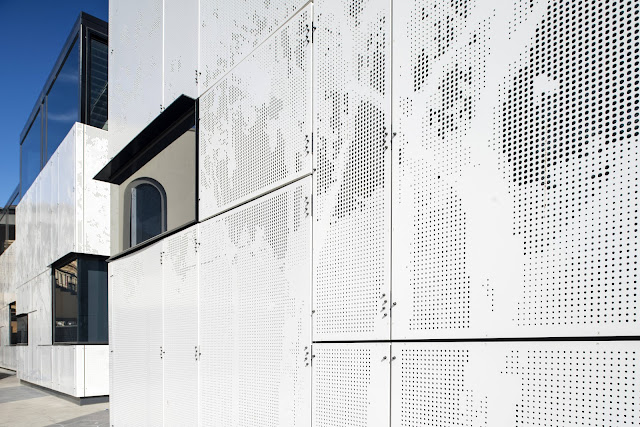Why Use “Perforated Metal” Instead of “Glass” in an Architecture Project?
Buildings of all sizes are increasingly being covered with perforated metal panels. Perforated metal has square, circular, hexagonal, or custom-shaped holes that mimic a grid or mesh. The holes reduce the amount of weight that the structure must sustain. Different gauges, or thicknesses, are available and chosen depending on anticipated wind loads and other considerations such as ventilation. Perforated metal siding is less complicated to install than other sidings, and it has a long-anticipated service life.
As architects seek to achieve new heights of sustainable building design, perforated zinc metal continues to rise above wood and glass as the top facade material choice:
Optional Customization and Adaptability
Perforated metal is unlike any other façade material in that it can be modified. It allows architects to create distinctive buildings without sacrificing façade functionality. Words, drawings, logos, and images may all be spelled out using perforations created using CAD software. A metal screen with perforations may be folded to make complex building envelopes.
Options for All Project Budgets
If project finances do not allow for a bespoke perforated metal building front, standard profile zinc metal may be changed via metal treatment.
Metal manufactures can assist you in choosing colours, aged or metallic finishes, and other jaali design elements to help you create wow-factor perforated metal building facades while staying within your budget. We can also advise you on the best metal treatments for coastal or high-temperature environments.
Energy Conservation and Sustainability
When it comes to sustainability, zinc metal is one of the most environmentally friendly construction materials available. By regulating a structure's temperature, a perforated metal building façade may assist decrease energy expenditures. It also improves natural ventilation and circulation while reducing solar heat and glare.
Screening with a View
Shade and privacy are essential for building inhabitants. Because it enables light and vistas to shine through, a perforated metal building façade checks all the boxes. Zinc metal designed a metal shutter façade for the new Infinity flats in Canterbury, with 500 unique folded panels.
Environmentally Friendly
For a variety of reasons, metal is regarded as an ecologically beneficial construction material. Even though metal is produced from earth-mined ores, significant amounts are currently accessible due to a greater focus on metal recycling. Metal can be recycled several times, and recycled aluminium and other recycled metals make up a significant portion of the metal used to create perforated metal siding panels.
Because the waste generated by perforation is recyclable, perforations reduce the amount of metal required in each panel by 10 to 40%. Reduced material means less weight and cheaper fuel expenses for transporting siding to the construction site. When used as screening components for aluminium and glass curtain walls and parking garage applications, metal panels increase energy efficiency. In contrast, zinc panels enable light to flow freely, reducing the amount of interior lighting needed.
improves the appearance of any building
Perforated siding enhances the aesthetics of any structure. When zinc metal panels are used to screen glazing, light from the inside shines through the holes at night, giving the impression of openness while maintaining privacy. Perforated metal comes in various finishes and may be made to seem like copper, zinc, or stainless steel. The surface may be polished or painted to make it waterproof. Perforated metal siding provides the same level of protection as other kinds of jaali designs while also providing for better pressure equalization between the area behind the panel and the building's exterior.
On extensive high-rise structures exposed to varying wind loads, pressure equalization is critical to consider. Metal screen covering also bends better in response to significant buildings' natural swinging. Rainwater can get behind perforated metal panels; however, like many other kinds of metal cladding, the panels may be built with waterproof barriers behind the siding to enable rainwater to drain away without causing damage to the building.




Comments
Post a Comment